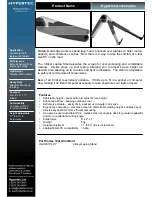
-37-
v5.8
Radios
7.7. Sigfox
Sigfox is a private company that aims to build a worldwide network especially designed for IoT devices. The network is cellular,
with thousands of base stations deployed in each country. Sigfox technology offers very long ranges for low-power, battery-
constrained nodes. Sigfox is great for very simple and autonomous devices which need to send small amounts of data to this
ubiquitous network, taking advantage on the Sigfox infrastructure.
So Sigfox is similar to cellular (GSM-GPRS-3G-4G) but is more energy-efficient, and the annual fees are lower.
Sigfox uses a UNB (Ultra Narrow Band) based radio technology to connect devices to its global network. The use of UNB is key
to providing a scalable, high-capacity network, with very low energy consumption, while maintaining a simple and easy to
rollout star-based cell infrastructure.
•
Frequency:
ISM 868 MHz
•
TX Power:
14 dBm
•
ETSI limitation:
140 messages of 12 bytes, per module per day
•
Range:
Typically, each base station covers some km. Check the
•
Chipset consumption:
TX: 49 mA @ +14 dBm
•
Radio Data Rate:
100 bps
•
Receive sensitivity:
-126 dBm
•
Sigfox certificated:
Class 0u (the highest level)
The network operates in the globally available ISM bands (license-free frequency bands) and co-exists in these frequencies
with other radio technologies, but without any risk of collisions or capacity problems. Sigfox currently uses the most popular
European ISM band on 868MHz (as defined by ETSI and CEPT).
Sigfox is being rolled out worldwide. It is the responsibility of the system integrator to consult the catalog of
(Sigfox
Network Operators) for checking coverage in the deployment area.
The Sigfox back-end provides a web application interface for device management and configuration of data integration, as well
as standards based web APIs to automate the device management and implement the data integration.
All the information about their programming and operation can be found in the Sigfox Networking Guide available at
of Libelium website.
Figure : Sigfox network
















































